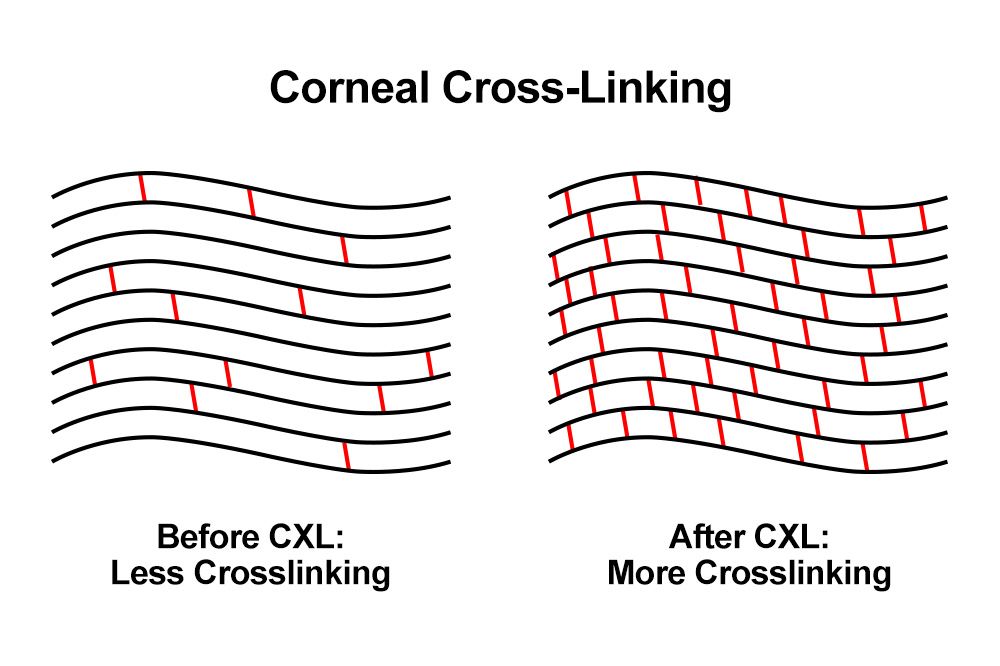Corneal Cross-linking Treatment
Approximately one out of every 750 Americans is affected by an eye disease called keratoconus. The condition, which causes the cornea to become weak, thin, and irregularly shaped, can greatly distort and diminish vision. In serious cases, patients may require a corneal transplant to restore vision. However, with advancements in technology, this disease can now be effectively treated using revolutionary, minimally invasive methods. Dr. Andrew Holzman provides corneal cross-linking as an effective procedure to help restore the shape of eyes distorted from keratoconus. In addition to helping prevent the need for a corneal transplant, there are several significant benefits of corneal cross-linking. To schedule a consultation at one of our Washington, DC-area practice locations, contact us today.
What is Corneal Cross-linking (CXL)?
Healthy corneas are able to retain their shape due to cross-linkage between collagen fibers. When keratoconus occurs, these cross links, or support beams, break down, weakening the cornea and causing the tissue to bulge outwards. CXL is a minimally invasive, biological solution that uses riboflavin eye drops and ultraviolet light to increase the amount of collagen links, strengthen the cornea, and help prevent further loss of vision. CXL treatment is fully approved by the the U.S. Food and Drug Administration (FDA). Our practice was one of the few approved clinical trial sites in the nation.

The purpose of corneal cross-linking is to fortify the cornea by increasing the number of attachments that bind the collagen fibers to each other.
The CXL Procedure
A CXL procedure is performed in-office, and does not require any surgical incisions or stitches. The relatively non-invasive procedure can be completed in less than two hours, and has been proven to prevent further vision loss in over 95 percent of patients. We begin by applying anesthetic eye drops before gently removing the surface cells of the cornea. Once the eye is prepared, we apply riboflavin drops to enhance the strengthening effect of collagen and protect the rest of the eye from ultraviolet light exposure. With the drops in place, you will look at an ultraviolet light for the next three to eight minutes. A special contact lens will then be placed to act as a bandage. The lens is removed after about five days, and you will use anti-inflammatory and antibiotic drops for a further two weeks.
Studies have concluded that the results of CXL can last for years, and that the strengthening effect may be permanent.
Benefits from Strengthening the Cornea
By strengthening the cornea and adding cross links, patients may experience:
- Improved Vision: Up to 81 percent of patients who undergo CXL will be able to see more clearly after treatment.
- Less Invasive Technique: As opposed to a corneal transplant, which requires a surgical procedure, CXL is minimally invasive.
- Long-lasting Results: Studies have concluded that the results of CXL can last for years, and that the strengthening effect may be permanent.
- Shorter Recovery: A corneal transplant can require a lengthy, painful recovery. In contrast, CXL allows patients to return to normal activities within days.
Refining Your Vision
After the completion of your CXL procedure, you may choose to have an excimer laser treatment (PRK) to further improve your vision. However, even without further treatment, your vision should improve. Patients typically begin to notice positive effects within four to eight weeks after their CXL procedure, and major improvements after three to six months.
Most patients can return to wearing contact lenses as early as two weeks after the procedure. Because of their improved vision, patients often need to update their old prescription for corrective eyewear.
Types of Corneal Cross-linking Procedures
Epithelium-off CXL
During epithelium-off CXL, Dr. Holzman will remove the outer layer of your cornea, known as the epithelium. With this technique, the riboflavin drops can penetrate your cornea much more easily. Epithelial cells will heal on their own within a few days. Dr. Holzman only performs the FDA approved Epithelium-off CXL
Epithelium-on CXL
During epithelium-on CXL, the epithelium is left intact. This technique will allow for faster healing and reduced risk for infection. However, studies show that epithelium-on CXL may not be as effective as an epithelium-off procedure. Typically, this technique is most successful on patients under age 35. It is not yet FDA approved.
CXL Results and Recovery
Once your procedure is complete, Dr. Holzman will prescribe antibiotic and anti-inflammatory eye drops. He may also place a healing contact lens over your eye, particularly if you have had epithelium-off CXL. The entire healing process should take no more than a few weeks. With epithelium-off CXL, you can usually resume your normal routine in five to seven days. If you have epithelium-on CXL, you can typically go back to your regular activities the following day.
Corneal cross-linking is primarily intended to stop your vision from getting worse. Immediately following your procedure, your vision may be a bit blurry, but it should improve over the next three to six weeks. Once you have recovered, you could enjoy stable vision that will last for many years, if not the rest of your life. In some cases, you could actually experience an improvement in your eyesight. Usually, this will become apparent several months after your procedure, when you may need a new glasses or contact lens prescription.



